Mechanistic Insight into the Pathology of Polyalanine Expansion Disorders Revealed by a Mouse Model for X Linked Hypopituitarism
Polyalanine expansions in transcription factors have been associated with eight distinct congenital human diseases. It is thought that in each case the polyalanine expansion causes misfolding of the protein that abrogates protein function. Misfolded proteins form aggregates when expressed in vitro; however, it is less clear whether aggregation is of relevance to these diseases in vivo. To investigate this issue, we used targeted mutagenesis of embryonic stem (ES) cells to generate mice with a polyalanine expansion mutation in Sox3 (Sox3-26ala) that is associated with X-linked Hypopituitarism (XH) in humans. By investigating both ES cells and chimeric mice, we show that endogenous polyalanine expanded SOX3 does not form protein aggregates in vivo but rather is present at dramatically reduced levels within the nucleus of mutant cells. Importantly, the residual mutant protein of chimeric embryos is able to rescue a block in gastrulation but is not sufficient for normal development of the hypothalamus, a region that is functionally compromised in Sox3 null embryos and individuals with XH. Together, these data provide the first definitive example of a disease-relevant PA mutant protein that is both nuclear and functional, thereby manifesting as a partial loss-of-function allele.
Published in the journal:
. PLoS Genet 9(3): e32767. doi:10.1371/journal.pgen.1003290
Category:
Research Article
doi:
https://doi.org/10.1371/journal.pgen.1003290
Summary
Polyalanine expansions in transcription factors have been associated with eight distinct congenital human diseases. It is thought that in each case the polyalanine expansion causes misfolding of the protein that abrogates protein function. Misfolded proteins form aggregates when expressed in vitro; however, it is less clear whether aggregation is of relevance to these diseases in vivo. To investigate this issue, we used targeted mutagenesis of embryonic stem (ES) cells to generate mice with a polyalanine expansion mutation in Sox3 (Sox3-26ala) that is associated with X-linked Hypopituitarism (XH) in humans. By investigating both ES cells and chimeric mice, we show that endogenous polyalanine expanded SOX3 does not form protein aggregates in vivo but rather is present at dramatically reduced levels within the nucleus of mutant cells. Importantly, the residual mutant protein of chimeric embryos is able to rescue a block in gastrulation but is not sufficient for normal development of the hypothalamus, a region that is functionally compromised in Sox3 null embryos and individuals with XH. Together, these data provide the first definitive example of a disease-relevant PA mutant protein that is both nuclear and functional, thereby manifesting as a partial loss-of-function allele.
Introduction
Trinucleotide repeat expansions are a relatively common cause of human disease. The expanded trinucleotide can occur in an untranslated region, for example in Fragile X syndrome in which a CGG repeat adjacent to the FMRI promoter causes hypermethylation and gene silencing. Alternatively repeat expansions can occur in exonic regions and result in elongation of homopolymeric amino acid tracts. For example polyglutamine (PQ) diseases such as Huntingtons disease, are associated with long unstable PQ-encoding stretches that lead to the production of a toxic species and late onset disease characterised by the loss of a subset of neurons. In addition to PQ encoding repeats, polyalanine (PA) repeat expansion has recently emerged as a significant cause of human disease. PA expansions have been linked to nine disorders of which eight are congenital and one is late onset. Each is caused by PA expansion in a separate gene, with the eight congenital disorders linked to PA expansions in developmentally-important transcription factors. These, and the associated disorders, are SOX3 (X linked Hypopituitarism), HOXA13 (hand–foot–genital syndrome), ARX (syndromic and non-syndromic X-linked mental retardation), HOXD13 (synpolydactyly type II), PHOX2B (congenital central hypoventilation syndrome), FOXL2 (blepharophimosis, ptosis and epicanthus inversus), ZIC2 (holoprosencephaly) and RUNX2 (cleidocranial dysplasia). The ninth is the ubiquitous RNA binding protein PABPN1 which is associated with the late onset disease oculopharyngeal muscular dystrophy (OPMD).
Despite considerable functional analyses, the mechanism by which PA expansion mutations cause disease is not completely understood. Phenotype/genotype correlations in humans and mouse models indicate that many PA alleles give rise to disease phenotypes that resemble (HOXA13, FOXL2, ZIC2) or are less severe (ARX) than null alleles, consistent with complete or partial loss-of-function (LOF) [1], [2], [3], [4]. In contrast, some PA alleles cause similar but more severe disease phenotypes than null alleles consistent with toxic gain-of-function (GOF) and/or dominant negative activity (HOXD13, PHOX2B) [5], [6]. Despite these differences in mode of inheritance, all PA proteins behave very similarly in vitro, such that over-expression in cell culture results in the generation of cytoplasmic and/or nuclear aggregates, which are likely to arise through protein misfolding [7], [8], [9]. While the relevance of cellular aggregates to PA disease in general is unclear, nuclear inclusions that contain mutant PAPBN1 protein are a hallmark of OPMD [10], suggesting that aggregates may also form in patients with PA expansion mutations in developmental transcription factors. Protein aggregation also occurs in the related polyglutamine (PQ) disorders where PQ expansion confers toxic GOF [11], [12]. Together, these data suggest that aggregate formation may have a pathogenic role in PA disease alleles with GOF activity. However, the critical question of whether aggregates form in vivo and, if so, how they may be implicated in the pathogenesis of LOF PA diseases remains unresolved.
To investigate these issues, we used targeted mutagenesis of ES cells to generate a 26 alanine PA tract expansion mutation in Sox3 (Sox3-26ala). The analogous human mutation causes X linked Hypopituitarism (XH), a disease in which hemizygous males have GH deficiency (resulting in short stature) and fully penetrant intellectual disability [13]. Importantly, we find no evidence of SOX3-26ala aggregate formation in neural derivatives of targeted ES cells in vivo or in neurodifferentiated ES cell cultures. Instead, the Sox3-26ala mutation leads to a massive reduction in SOX3 protein within the nucleus. We also present developmental and biochemical evidence that residual mutant protein retains some activity, indicating that Sox3-26ala functions as a partial LOF allele.
Results/Discussion
In order to study the effects of disease-associated PA expansion at a cellular level we created R1 ES cells with a targeted mutation of Sox3. Homologous recombination was used to generate XY ES cells carrying a 36 bp expansion in the first PA tract of Sox3, extending the tract from 14 to 26 alanines (referred to hereafter as Sox3-26ala ES cells; Figure 1). Morula injection of mutant ES cells resulted in chimeras with up to 95% mutant cell contribution as assessed by coat colour (Table 1). None of these chimeras displayed any evidence of growth retardation (consistent with the absence of short stature in heterozygous female carriers of the human SOX3-26ala mutation who also contain a mixture of WT and mutant cells, due to X inactivation [13]). However, despite extensive breeding, none of these chimeras exhibited germline transmission of the mutant allele. In contrast, germline competence was demonstrated with WT parental ES cells as well as a clone carrying the PGK-Neo cassette without the PA tract expansion (referred to hereafter as Neo ES cells). These data suggest that the PA mutation in Sox3 had caused a block in male fertility. This is consistent with a recently published report demonstrating that Sox3 LOF in the germ cell lineage resulted in an early defect in spermatogenesis and the lack of any reported transmission of the human SOX3-26ala allele from hemizygous males [13], [14].
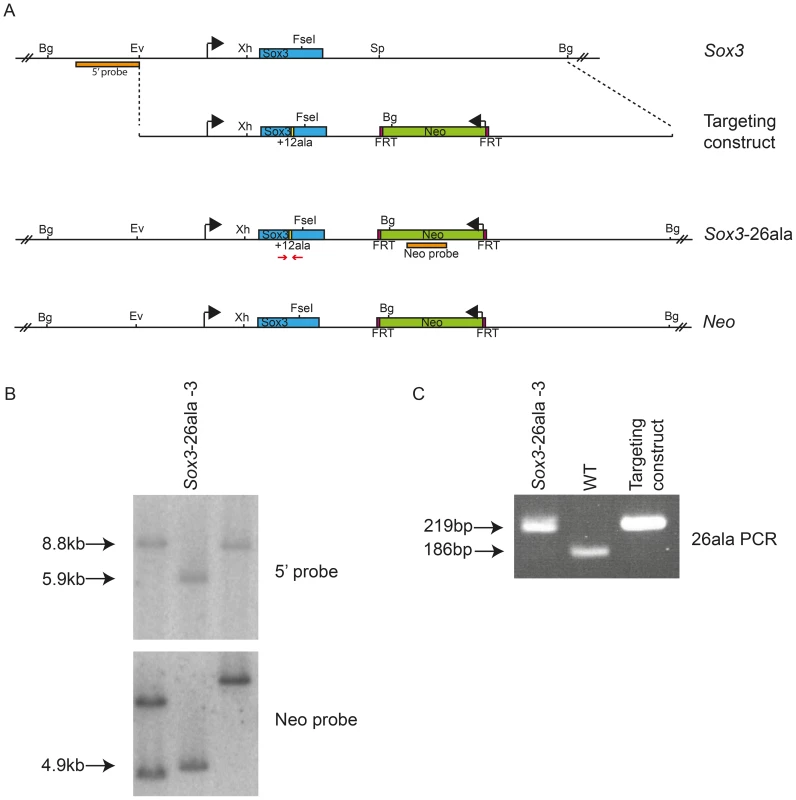

Since we were unable to transmit the Sox3-26ala mutation through the male germline, the phenotypic consequences of the mutation were initially investigated in Sox3-26ala <-> WT chimeric embryos. Immunostaining with a SOX3-specific antibody revealed a dramatic reduction in SOX3 protein in 13.5 dpc telencephalic ventricular zone cells expressing the Sox3-26ala allele (identified by NEO-immunoreactivity) in comparison to neighbouring WT cells (Figure 2A). The ability of the antibody to detect mutant protein was confirmed by staining COS-7 cells expressing exogenous mouse Sox3-26ala, in which large peri-nuclear and cytoplasmic aggregates were common (Figure S1). A striking reduction in mutant SOX3 protein was also observed in 7.5 dpc, 9.5 dpc, 10.5 dpc and 11.5 dpc chimeras (Figure 3 and Figure S2) indicating that this phenotype was not stage-dependent. High power microscopy failed to detect any cytoplasmic or nuclear aggregates of mutant protein but did reveal a very low level of protein in the nucleus (Figure 2A). Comparison of Sox3-26ala and Sox3-null embryonic CNS cells confirmed that the low level of SOX3-26ala protein that we observed was not due to background signal (Figure 2B). Mutant cells appeared morphologically normal and there was no apoptotic induction as assessed by staining for activated Caspase3 (Figure S3). To further characterise the cellular phenotype of Sox3-26ala mutant cells, we performed neurodifferentiation of Sox3-26ala ES cells (which are XY and therefore lack a WT Sox3 allele). Immunohistochemical analysis confirmed the overwhelming reduction of nuclear SOX3 protein in mutant cultures (Figure 2C) in which the expression of other neural progenitor markers were unaffected (data not shown). Rare cells with near normal levels of nuclear mutant protein were also detected but in no case was there evidence of protein aggregation (Figure 2C). Western blot analysis further supported the near complete loss of steady-state SOX3 protein levels in mutant cells (Figure 2D). As triplet repeat expansion mutations have been shown to affect mRNA transcription [12], we compared Sox3 message levels in WT and mutant cells in vitro and in vivo using qPCR and in situ hybridisation, respectively (Figure 2E–2F). No difference in Sox3 mRNA level was detected, indicating that the massive reduction in SOX3 protein levels in the mutant cells has a post-transcriptional aetiology and presumably occurs via degradation of misfolded protein [8]. This was supported by in vitro transcription/translation analysis which indicated that translation of the mutant transcript was unaffected by the PA mutation (Figure S4).
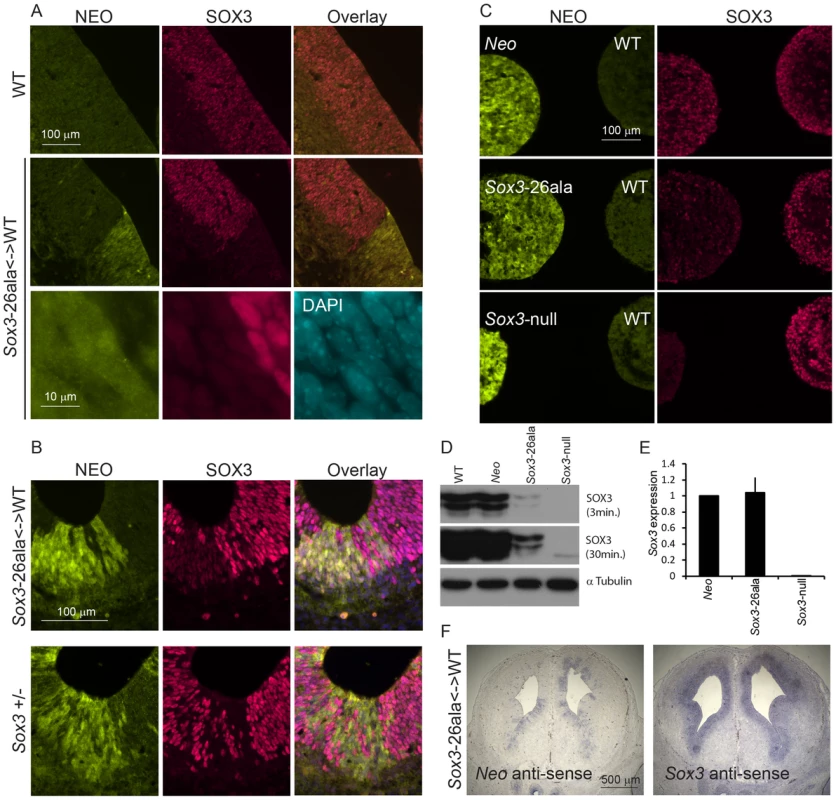
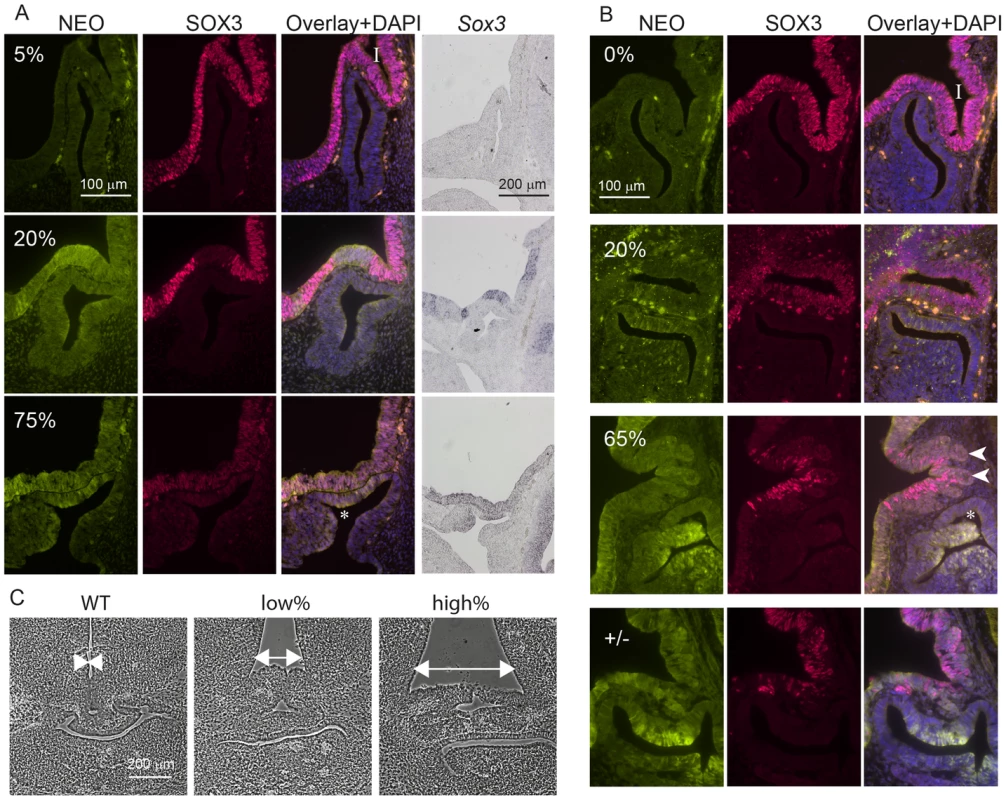
Taken together, these results indicate that Sox3-26ala is a LOF allele and argue strongly against a role for aggregation in the pathogenesis of XH. To further investigate LOF as the mechanism of disease, we compared the development of the hypothalamus, infundibulum and anterior pituitary in Sox3-26ala chimeric embryos to Sox3 heterozygous embryos that carry a complete LOF (null) allele. Sox3 +/− embryos exhibit a defect in infundibular development that results in aberrant induction and bifurcation of the anterior pituitary primordium, Rathke's Pouch (RP) [15] accompanied by expansion of the floor of the ventral diencephalon (Figure 3). Similar defects in infundibular morphology and pituitary localisation have also been identified in XH patients [16]. Importantly, 13.5 dpc and 11.5 dpc high percentage Sox3-26ala <-> WT chimeras exhibited dysmorphology of the infundibulum, Rathke's Pouch and ventral diencephalon that was indistinguishable from Sox3+/− embryos (Figure 3). These abnormalities were also present in low percentage chimeras, although were less severe consistent with the loss of SOX3 function being responsible for this phenotype. Notably, there was an obvious reduction in SOX3 protein in mutant (NEO+) cells thereby confirming that PA expansion has a functional impact in neural cells that are directly implicated in XH pathology.
Having established that Sox3-26ala behaves as a LOF allele, we next considered whether the low level of remnant SOX3 protein in mutant cells was functional. To investigate this, we initially performed transactivation assays in COS-7 cells using wild type and mutant human and mouse SOX3 expression constructs and a luciferase reporter containing four SOX consensus motif (SOCM) binding sites. Both mouse and human SOX3-26ala proteins showed activity in this assay that was significantly higher than background (Figure 4A). However, consistent with previous reports [7], [16], this activity was much lower than WT SOX3 protein. To investigate whether this reduction was caused by lower nuclear protein levels or an inherent defect in mutant protein transactivation activity, we measured that relative amount of WT and mutant SOX3 protein in the nucleus of transfected cells by Western Blot (Figure 4B). We observed a reduction of similar magnitude to the reduced luciferase output, suggesting that the mutant protein that is present in the nucleus has similar activity to WT. To investigate whether the residual nuclear SOX3-26ala protein is functional in vivo we compared the phenotypes of 7.5 dpc chimeras generated from either Sox3-null or Sox3-26ala ES cells, as it has been reported that Sox3-null ES cell <-> WT embryo chimeras exhibit severe gastrulation defects [15]. As previous analysis of Sox3-null ES cell chimeras was not performed with R1 ES cells (the parent line used to generate the 26ala mutant ES cells), we generated R1 Sox3-null ES cells for this experiment. Consistent with previous reports, a high proportion (52%) of Sox3-null ES cell chimeras generated abnormal gastrulae (Figure 5). In contrast, only 19% of Sox3-26ala ES cell <-> WT embryo 7.5 dpc chimeras were morphologically abnormal which was not significantly different to the proportion of abnormal chimeric embryos generated using Sox3-flox control ES cells (Figure 5). Immunostaining of Sox3-26ala chimeras revealed a reduction in SOX3 protein levels that was similar to later embryonic stages (Figure S1). These data indicate that nuclear SOX3-26ala protein is functional in vivo and is sufficiently abundant to prevent overt defects in gastrulation. We therefore conclude that Sox3-26ala is a partial LOF allele.
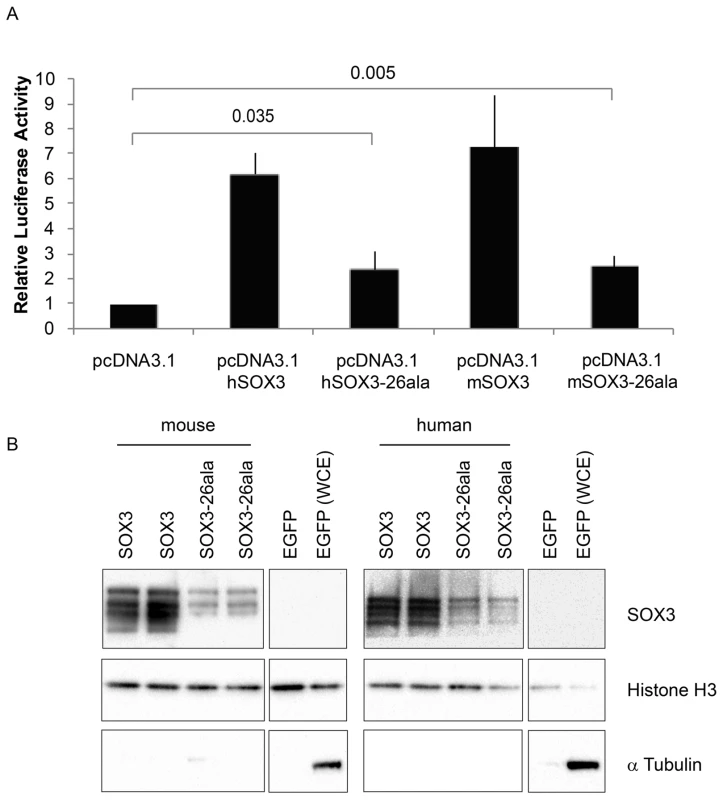
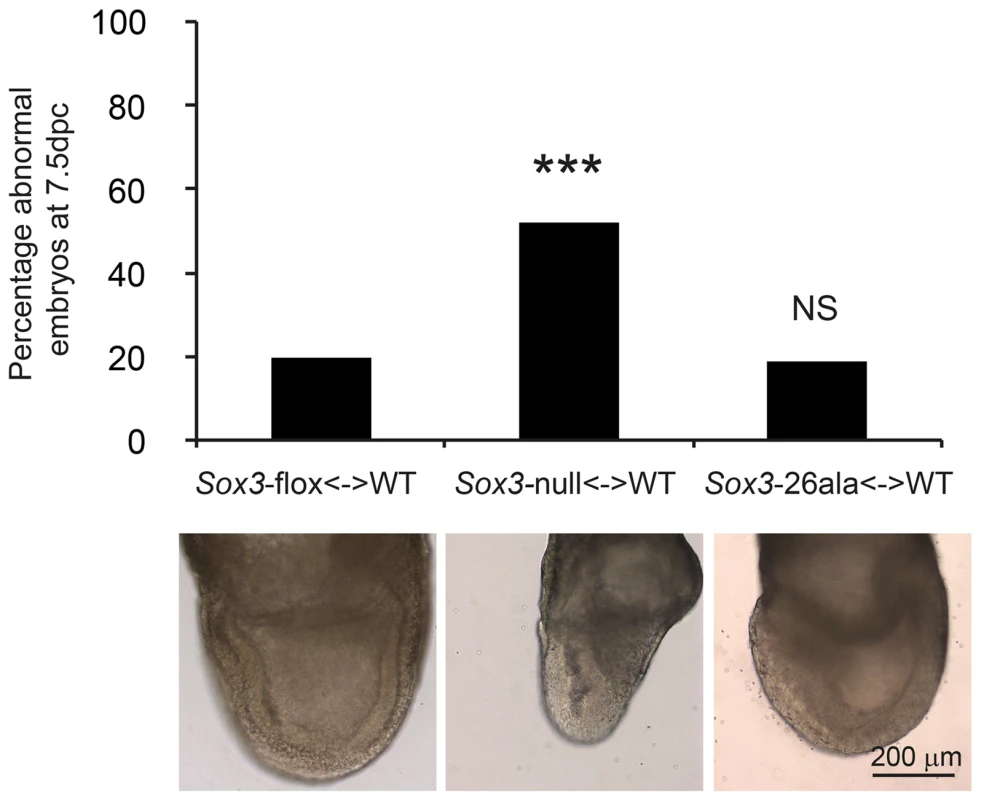
This study represents the first investigation of the disease-associated Sox3-26ala mutation under the control of the endogenous locus in a whole animal setting. The complete lack of aggregates in SOX3 positive CNS zones (including the hypothalamic-pituitary axis) provides strong evidence that aggregation is not a feature of the human disease. In contrast, our data demonstrate that PA expansion results in a dramatic reduction in SOX3 protein due to a post-translational defect. Given that PA expansion proteins co-localise with chaperones in vitro and that aggregation is promoted by pharmacological inhibition of the proteasome [8], it seems likely that mutant SOX3 protein misfolds and is cleared from the cell. Of note, the small amount of protein that remains translocates to the nucleus and is functionally active. The level of protein that remains is sufficient for some developmental contexts but not others (i.e. gastrulation but not pituitary induction). This context-specific threshold of SOX3 activity may explain why XH patients with SOX3 PA mutations, but not null mutations, have been identified.
In direct contrast to the Hoxd13 (+7ala) spdh spontaneous mouse model in which mutant protein is mislocalised to the cytoplasm [8], our data provide the first definitive example of a disease-relevant PA mutant protein that is both nuclear and functional, thereby manifesting as a partial LOF allele. Interestingly, mutant protein levels in the Hoxa13 and Arx PA mouse models, which also exhibit LOF inheritance, are diminished but not abolished by western blot and whole mount immunodetection [1], [17]. This raises the possibility that nuclear localisation of suboptimal levels of functional protein may be a feature of several PA diseases. In the case of ARX, the PA mutant mouse model has been reported to have normal nuclear localisation of mutant protein in some tissues, but to have a reduction in the total number of positive cells [17], [18]. Given our data, an alternative interpretation is that cells expressing ARX are not lost but are unable to be detected due to misfolding and clearance of the mutant protein. In situ hybridisation of Arx transcripts should provide a means of discriminating between these possibilities.
In addition to SOX3-26ala, XH is also associated with a 7 alanine expansion mutation (SOX3-22ala) in the same polyalanine tract [16], [19], [20]. Although SOX3-22ala is occasionally associated with mild learning difficulties [20], it is interesting to note that the infantile behaviour/severe MR that is fully penetrant in SOX3-26ala-carrying males is not found in affected males with the SOX3-22ala expansion mutation, suggesting that the shorter expansion is less severe. Given our data showing a massive depletion of SOX3 protein in Sox3-26ala mutant cells in vivo, we would predict that SOX3-22ala protein would also be reduced (compared to WT) but to a lesser extent than the SOX3-26ala protein. This higher level (and therefore activity) of SOX3-22ala compared to SOX3-26ala would be sufficient for “cognitive” CNS development. Consistent with this idea, the SOX3-22ala protein is less prone to aggregate formation in cell culture [7], [16], although one must be cautious in interpreting pathological mechanism from over expression studies in heterologous cell lines. While it would be useful to directly compare SOX3-26ala and SOX3-22ala levels in vivo, a mouse model of the SOX3-22ala mutation has not been generated. However, given that it is now possible to generate neural precursors directly from patients via iPS cells, it would be interesting to compare the SOX3 protein levels in neuroprogenitors derived from SOX3-22ala and SOX3-26ala carrying males. This approach might also be informative for PA disorders in general, particularly given that increased disease severity is generally associated with longer PA expansions [21].
Based on these and other published data, we propose that both GOF and LOF PA disease alleles are associated with a primary defect in protein folding but that a critical difference in the capacity of cells to clear mutant protein results in either the accumulation of mislocalised cytoplasmic protein (GOF) or a diminished level of functional nuclear protein (LOF). As indicated by earlier reports [21], the former mechanism provides scope for dominant-negative and toxic GOF through cytoplasmic sequestration of endogenous binding partners. In the latter, we propose that misfolded protein is efficiently cleared by the cell without significant perturbation of other cellular processes, manifesting as LOF or partial LOF, depending on the amount of residual functional protein. Factors that determine whether or not a cell is able to efficiently clear the misfolded protein could include the level of expression, local concentration differences within the cell, the efficiency of the degradation pathway within different affected cell types and the length of the PA expansion. We propose that the aggregates seen when SOX3-26ala and all other PA expansion proteins are expressed in vitro reflect the overloading of the cell with mutant protein such that normal degradation pathways are overwhelmed. Resolution of the factors that determine whether a cell is able to clear or tolerate mutant protein will have broader implications for proteinopathies such as Alzheimers Disease and Huntingtons Disease in which only subsets of cells display aggregation. For the future, it will be interesting to determine the behaviour of mutant protein in other PA mouse models with GOF and LOF inheritance and, where possible, in patient-derived induced pluripotent stem (iPS) cell derivatives.
Methods
ES cell targeting
Sox3-26ala allele
The targeting vector was based on a Sox3-Neo floxed vector published previously in which GFP and the loxP sites were removed and a 36 bp insertion was introduced to the existing 42 bp alanine encoding tract [15]. This was electroporated into 129 strain-derived (R1) mouse ES cells and 1000 G418 resistant clones were screened by Southern blotting. Integration at the Sox3 locus was determined by a shift in a BglII fragment from 8.8 kb to 5.9 kb when probed with a 5′Sox3 probe [15]. Clones were subsequently screened for the alanine expansion using PCR primers flanking the alanine tract; 5′-AGACGCTGCTCAAGAAGGAC-3′ and 5′-CTGCACGAGCGAGTAGGC-3′. Clones targeted with the Neo cassette but lacking the Sox3-26ala expansion were designated (Neo).
Null allele
The targeting vector for generation of the null allele was the Sox3-Neo floxed vector published previously [15]. 400 clones were screened using the above probe and homologous recombinants identified by a shift in the BglII fragment from 8.8 kb to 7.5 kb. Two correctly targeted clones were transiently transfected with a Cre recombinase expression plasmid (kind gift from Duncan Hewett), seeded at clonal density and screened by PCR for the absence of Sox3. Putative Sox3 null clones were confirmed by Southern blotting (5 kb BglII fragment using the 5′Sox3 probe, as above).
Chimera generation
129 derived ES clones were injected into c57/Bl6xB6D2F1 2.5 dpc morula, cultured overnight and transferred as blastocysts into the uterus of 2.5 dpc pseudopregnant recipients.
ES cell culture and neurodifferentiation
R1 ES cells were maintained on irradiated MEFs in standard conditions and neurodifferentiated either in aggregates in chemically defined media as described in [22] referred to as (CDM) or as monolayers as previously described [23], referred to as (N2B27).
qPCR gene expression and estimation of percentage chimerism
RNA was prepared with Trizol (Invitrogen) and reverse transcribed with a High Capacity RNA-to-cDNA kit (ABI). qPCR was performed using Fast SYBR Green Master Mix (ABI) and run on an ABI 7500 StepOnePlus system. Primer sequences and lengths of amplified products were: Sox3 (117 bp) 5′-GAACGCATCAGGTGAGAGAAG-3′ and 5′-GTCGGAGTGGTGCTCAGG-3′, β-Actin (89 bp) 5′-CTGCCTGACGGCCAGG-3′ and 5′-GATTCCATACCCAAGAAGGAAGG-3′. Sox3 expression was normalised to β-Actin and expressed as relative quantity (RQ) using ABI software. Embryonic chimerism was determined against a standard curve of Sox3 dosage generated from adult gDNA of WT and Sox3-null mixed 0∶100, 25∶75, 50∶50, 100∶0. Loading was corrected using primers against Sox1 (171 bp) 5′-GACTTGCAGGCTATGTACAACATC-3′ and 5′-CCTCTCAGACGGTGGAGTTATATT-3′ and Ngn3 (120 bp) 5′-CCCCAGAGACACAACAACCT-3′ and 5′-AGTCACCCACTTCTGCTTCG-3′. Chimerism in Figure 2C was estimated by NEO IF and ISH.
ISH and IF
Embryos were fixed in 4% PFA overnight and CDM bodies were fixed for 15 minutes. Both were then equilibrated in 30% sucrose overnight, set in OCT compound and cryosectioned on a Leica CM1900 at 10 µm. ISH on fixed frozen sections was performed using a Sox3 probe from a fragment generated with the following primers; 5′-AGCGCCTGGACACGTACAC-3′ and 5′-AGCGCCTGGACACGTACAC-3′ and a Neo probe from a fragment amplified with the following primers; 5′-GATCGATCCCCTCAGAAGAAC-3′ and 5′-GGCTATTCGGCTATGACTGG-3′. Images were captured on a Zeiss Axiophot upright microscope with AnalySIS software, using a 2.5× (Zeiss Neofluar; NA0.5) or a 10× (Zeiss Neofluar; NA0.3) objective lens. Primary antibodies and dilutions were goat anti-hSOX3 (R&D #AF2569,1∶150) and rabbit anti-NTPII (Millipore #06-747, 1∶150). Imaging of IF was performed on a Zeiss Axioplan2 upright microscope with Axiovision software, using a 20× (Zeiss Apochromat; NA0.75) or a 100× (Zeiss Apochromat; NA1.3) objective lens.
Western blotting
Day4 N2B27 neurodifferentiated ES cells were lysed in RIPA buffer supplemented with protease inhibitors. SDS loading buffer was added and the samples were resolved by 10% SDS-PAGE. Duplicate gels were subjected to immunoblot analysis using anti-hSOX3 (1∶2500) and anti-α-Tubulin (Sigma #T8203, 1∶2500) antibodies since both detect proteins at ∼40 kD. Signals were developed using ECL substrate (West Pico, Pierce). For nuclear protein lysates, cells were subjected to hypotonic lysis (10 mM HEPES pH 7.9, 1.5 mM MgCl2, 10 mM KCl, 0.4% NP-40, 10% Ficoll-400, 1 mM DTT, 1 mM PMSF, 1× protease inhibitors), centrifugation to pellet nuclei that were then washed in wash buffer (10 mM HEPES pH 7.9, 1.5 mM MgCl2, 150 mM KCl, 10% Ficoll-400, 1 mM DTT, 1 mM PMSF, 1× protease inhibitors) and lysed in nuclear extract buffer (20 mM HEPES pH 7.9, 1.5 mM MgCl2, 0.5 mM EDTA, 20% glycerol, 0.42 M KCl, 1 mM DTT, 1 mM PMSF, 1× protease inhibitors).
Luciferase transcription assay
Transcriptional activities of mouse and human SOX3 and SOX3-26ala were determined using the Dual-Luciferase Reporter Assay System (Promega). 1.0 µg of plasmid DNA was transfected into COS-7 cells using Lipofectamine according to manufacturer's instructions. All transfections were performed in triplicate and contained luciferase reporter Sox Consensus Motif (SOCM; 4×AACAAAG) [7], Renilla luciferase plasmid pRL-CMV and one of pcDNA3.1, pcDNA3.1 hSOX3, pcDNA3.1 hSOX3-26ala, pcDNA3.1 mSOX3 or pcDNA3.1 mSOX3-26ala expression constructs (Promega). The firefly luciferase and Renilla luciferase activities were determined after 48 h on a FluorStar Optima (BMG technologies). Relative luciferase activity is the ratio of firefly to Renilla normalised to pcDNA3.1. The assay was repeated four times. Statistical analysis was performed using Student's T-test (two tailed, unequal variance).
Ethics statement
Animal experiments were approved by the University of Adelaide Animal Ethics Committee. All studies were conducted in accordance with the principles of animal replacement and reduction and experimental refinement. Animals were monitored daily for evidence of illness and, if distressed, were culled immediately by cervical dislocation by an experienced investigator/animal technician.
Supplementary methods
Cell free transcription/translation
Cell free transcription/translation was performed using the TnT Coupled Reticulocyte Lysate System (Promega, #L4610) as per manufacturer's instructions. Plasmids used were 250 ng of either pcDNA3.1 hSOX3, pcDNA3.1 hSOX3-26ala, pcDNA3.1 mSOX3 or pcDNA3.1 mSOX3-26ala. Reactions were resolved on a Bio-Rad 10% precast gel (#456-1033), transferred to PVDF membrane, exposed to phosphor-screen and scanned.
COS-7 aggregation assay
COS-7 cells were grown on glass coverslips, transfected with one of pcDNA3.1, pcDNA3.1 hSOX3, pcDNA3.1 hSOX3-26ala, pcDNA3.1 mSOX3 or pcDNA3.1 mSOX3-26ala using Fugene6 (Roche) and stained with SOX3 antibody and DAPI two days later. At least 100 cells were scored randomly from each condition. Results are shown as the mean of three independent experiments and error bars represent one standard deviation.
Supporting Information
Zdroje
1. InnisJW, MortlockD, ChenZ, LudwigM, WilliamsME, et al. (2004) Polyalanine expansion in HOXA13: three new affected families and the molecular consequences in a mouse model. Hum Mol Genet 13: 2841–2851.
2. De BaereE, BeysenD, OleyC, LorenzB, CocquetJ, et al. (2003) FOXL2 and BPES: mutational hotspots, phenotypic variability, and revision of the genotype-phenotype correlation. Am J Hum Genet 72: 478–487.
3. RoesslerE, LacbawanF, DubourgC, PaulussenA, HerbergsJ, et al. (2009) The full spectrum of holoprosencephaly-associated mutations within the ZIC2 gene in humans predicts loss-of-function as the predominant disease mechanism. Hum Mutat 30: E541–554.
4. ShoubridgeC, FullstonT, GeczJ (2010) ARX spectrum disorders: making inroads into the molecular pathology. Hum Mutat 31: 889–900.
5. BrisonN, TylzanowskiP, DebeerP (2011) Limb skeletal malformations - what the HOX is going on? Eur J Med Genet 55: 1–7.
6. DubreuilV, RamanantsoaN, TrochetD, VaubourgV, AmielJ, et al. (2008) A human mutation in Phox2b causes lack of CO2 chemosensitivity, fatal central apnea, and specific loss of parafacial neurons. Proc Natl Acad Sci U S A 105: 1067–1072.
7. WongJ, FarlieP, HolbertS, LockhartP, ThomasPQ (2007) Polyalanine expansion mutations in the X-linked hypopituitarism gene SOX3 result in aggresome formation and impaired transactivation. Front Biosci 12: 2085–2095.
8. AlbrechtAN, KornakU, BoddrichA, SuringK, RobinsonPN, et al. (2004) A molecular pathogenesis for transcription factor associated poly-alanine tract expansions. Hum Mol Genet 13: 2351–2359.
9. NasrallahIM, MinarcikJC, GoldenJA (2004) A polyalanine tract expansion in Arx forms intranuclear inclusions and results in increased cell death. J Cell Biol 167: 411–416.
10. CaladoA, TomeFM, BraisB, RouleauGA, KuhnU, et al. (2000) Nuclear inclusions in oculopharyngeal muscular dystrophy consist of poly(A) binding protein 2 aggregates which sequester poly(A) RNA. Hum Mol Genet 9: 2321–2328.
11. DaviesSW, TurmaineM, CozensBA, DiFigliaM, SharpAH, et al. (1997) Formation of neuronal intranuclear inclusions underlies the neurological dysfunction in mice transgenic for the HD mutation. Cell 90: 537–548.
12. La SpadaAR, TaylorJP (2010) Repeat expansion disease: progress and puzzles in disease pathogenesis. Nat Rev Genet 11: 247–258.
13. LaumonnierF, RonceN, HamelBC, ThomasP, LespinasseJ, et al. (2002) Transcription factor SOX3 is involved in X-linked mental retardation with growth hormone deficiency. Am J Hum Genet 71: 1450–1455.
14. LarondaMM, JamesonJL (2011) Sox3 functions in a cell-autonomous manner to regulate spermatogonial differentiation in mice. Endocrinology 152: 1606–1615.
15. RizzotiK, BrunelliS, CarmignacD, ThomasPQ, RobinsonIC, et al. (2004) SOX3 is required during the formation of the hypothalamo-pituitary axis. Nat Genet 36: 247–255.
16. WoodsKS, CundallM, TurtonJ, RizottiK, MehtaA, et al. (2005) Over- and underdosage of SOX3 is associated with infundibular hypoplasia and hypopituitarism. Am J Hum Genet 76: 833–849.
17. KitamuraK, ItouY, YanazawaM, OhsawaM, Suzuki-MigishimaR, et al. (2009) Three human ARX mutations cause the lissencephaly-like and mental retardation with epilepsy-like pleiotropic phenotypes in mice. Hum Mol Genet 18: 3708–3724.
18. PriceMG, YooJW, BurgessDL, DengF, HrachovyRA, et al. (2009) A triplet repeat expansion genetic mouse model of infantile spasms syndrome, Arx(GCG)10+7, with interneuronopathy, spasms in infancy, persistent seizures, and adult cognitive and behavioral impairment. J Neurosci 29: 8752–8763.
19. Burkitt WrightEM, PerveenR, ClaytonPE, HallCM, CostaT, et al. (2009) X-linked isolated growth hormone deficiency: expanding the phenotypic spectrum of SOX3 polyalanine tract expansions. Clin Dysmorphol 18: 218–221.
20. AlatzoglouKS, KelbermanD, CowellCT, PalmerR, ArnholdIJ, et al. (2011) Increased transactivation associated with SOX3 polyalanine tract deletion in a patient with hypopituitarism. J Clin Endocrinol Metab 96: E685–690.
21. AlbrechtA, MundlosS (2005) The other trinucleotide repeat: polyalanine expansion disorders. Curr Opin Genet Dev 15: 285–293.
22. WatayaT, AndoS, MugurumaK, IkedaH, WatanabeK, et al. (2008) Minimization of exogenous signals in ES cell culture induces rostral hypothalamic differentiation. Proc Natl Acad Sci U S A 105: 11796–11801.
23. YingQL, StavridisM, GriffithsD, LiM, SmithA (2003) Conversion of embryonic stem cells into neuroectodermal precursors in adherent monoculture. Nat Biotechnol 21: 183–186.
Štítky
Genetika Reprodukční medicínaČlánek vyšel v časopise
PLOS Genetics
2013 Číslo 3
- Souvislost haplotypu M2 genu pro annexin A5 s opakovanými reprodukčními ztrátami
- Srdeční frekvence embrya může být faktorem užitečným v předpovídání výsledku IVF
- Mateřský haplotyp KIR ovlivňuje porodnost živých dětí po transferu dvou embryí v rámci fertilizace in vitro u pacientek s opakujícími se samovolnými potraty nebo poruchami implantace
- Primární hyperoxalurie – aktuální možnosti diagnostiky a léčby
- Příjem alkoholu a menstruační cyklus
Nejčtenější v tomto čísle
- Fine Characterisation of a Recombination Hotspot at the Locus and Resolution of the Paradoxical Excess of Duplications over Deletions in the General Population
- Molecular Networks of Human Muscle Adaptation to Exercise and Age
- Recurrent Rearrangement during Adaptive Evolution in an Interspecific Yeast Hybrid Suggests a Model for Rapid Introgression
- Genome-Wide Association Study and Gene Expression Analysis Identifies as a Predictor of Response to Etanercept Therapy in Rheumatoid Arthritis
